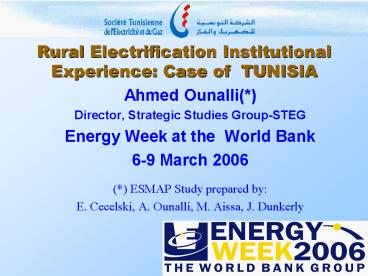Rural Electrification Institutional Experience: Case of TUNISIA - PowerPoint PPT Presentation
1 / 24
Title:
Rural Electrification Institutional Experience: Case of TUNISIA
Description:
1962: Tunisian Electricity & Gas Company (STEG) 1973 1976: technical & economic studies lead to ... 3- Phase MV main line. Three Pillars of Rural Development ... – PowerPoint PPT presentation
Number of Views:63
Avg rating:3.0/5.0
Title: Rural Electrification Institutional Experience: Case of TUNISIA
1
Rural Electrification Institutional Experience
Case of TUNISIA
- Ahmed Ounalli()
- Director, Strategic Studies Group-STEG
- Energy Week at the World Bank
- 6-9 March 2006
- () ESMAP Study prepared by
- E. Cecelski, A. Ounalli, M. Aissa, J. Dunkerly
2
RURAL ELECTRIFICATION RATE BY REGION2004
OVERAL Electrification Rate 98.9National
Rural ER 97
3
Origins of the Program
- 1962 Tunisian Electricity Gas Company (STEG)
- 1973 1976 technical economic studies lead to
low cost three phase/single phase MALT
4
Tunisias Rural Electrification Program,1972-2004
5
MALT Configuration
3- Phase MV main line
Neutral
Fuse Cutout
Neutral
1- Phase MV branch
1- Phase transformer
1- Phase LV lines
Rural area
6
Three Pillars of Rural Development
- EDUCATION (human resource development and legal
rights) - HEALTH (family planning)
- RURAL ELECTRIFICATION (coordination with above)
7
Rural Village Electrified from a single-phase
line
8
LOCAL LEVEL ACTORS AND MAIN FUNCTIONS
- Oumda/Rural households
- Governorates
- Delegation
- STEG-District
- Represents rural hhlds
- Political authorities
- Implements electrification program
9
NATIONAL LEVEL ACTORS AND MAIN FUNCTIONS
- National Socio-Economic Plan infrastructure
investment for 5 years - Funding of Plan
- Define national program for RE
- Implementation from grid
- Implementation from PV
- Extra-budgetary funding
- Ministry of Economic Development and Commissariat
Général de Dévelopment Rural (CGDR) - Ministry of Industry and Energy
- STEG
- ANER
- National Solidarity Fund (FNS), Presidential Fund
10
Responsibilities for Rural Electrification in
Tunisia
11
(No Transcript)
12
Modern milk cow farming on an electrified farm
13
Silo for local wheat harvest located in rural
area
14
Selection process political level
- Five Year Plan targets areas for rural
development based on - income
- unemployment
- environmental quality
- gender status
- expected rate of return
- costs of job creation
- improved living conditions
- Potential RE projects and beneficiaries
identified within areas selected at regional
level - linked with rural development plans (health,
education, water, roads)
15
Selection process STEG
- Construction of cost estimates by STEG at
district level (site visits, feasibility study) - STEG provides cost scenario table to national
level planners at MDE Number of households and
costs by cost level and by Governorate - MDE selects projects by setting cost ceiling
- Five year plan is finalized and regional level
receives funds
16
COST CEILING
17
Financing Rural Electrification
- Regional Development Programme (PRD)
- Integrated Rural Development Programme (PRDI)
- Presidential Fund
- National Solidarity Fund
- Since 1977 external debt (ADB, World Bank, AFD,
Kuwait Fund) - Photovoltaic program suppliers, WB credits, NGOs
18
How connection to the grid is financed
- BUDGETARY FUNDS FOR AGREED CEILING (example of
9th Plan 2200 DT )
Ceiling US1530 (2200 TND/beneficiary-cluster)
Household 140 up to 420 (200 up to 600 TND) depending on Region (spread over 36 bills 72 months)
STEG 140 (200 TND) since 1987
Government up to 1250 (1800 TND) as a max, 82 of ceiling cost
EXTRA-BUDGETARY FUNDS (gt2200 DT) - National
Solidarity Fund - Presidential Fund
19
(No Transcript)
20
Installing an electric pole
21
Reasons for Success - 1
- National commitment
- education, health, rural electrification with
social equity - Integrated rural development context
- synergy effects of regional planning process
- Effective institutional approach
- well-defined, coordinated roles
- fair, established procedures including political
22
Reasons for Success - 2
- Well managed and innovative utility
- effective and efficient
- Lowering costs for rural electrification
- capacity to adapt technology to meet Tunisian
needs - Effective tariff policy
- financial viability
- Complementary PV strategy
- commitment and coordination
23
Conclusions
- Goal of providing electricity services to widely
scattered rural populations in Africa is
ACHIEVABLE - Need to adapt technology and financing procedures
to local context - Need for strong and consistant support from the
State
24
THANK YOU































